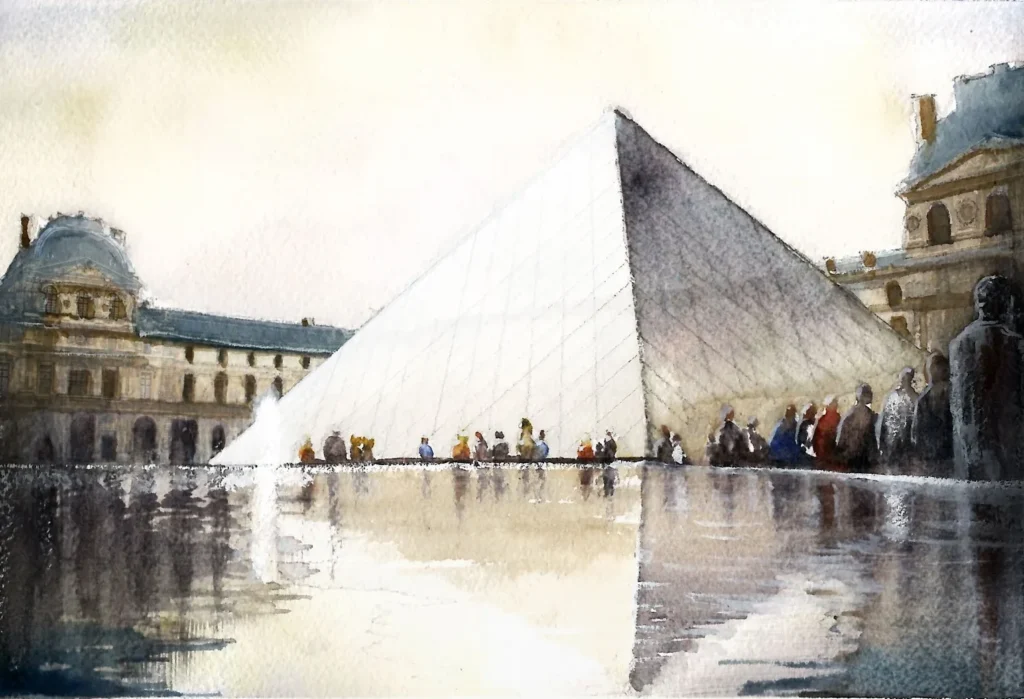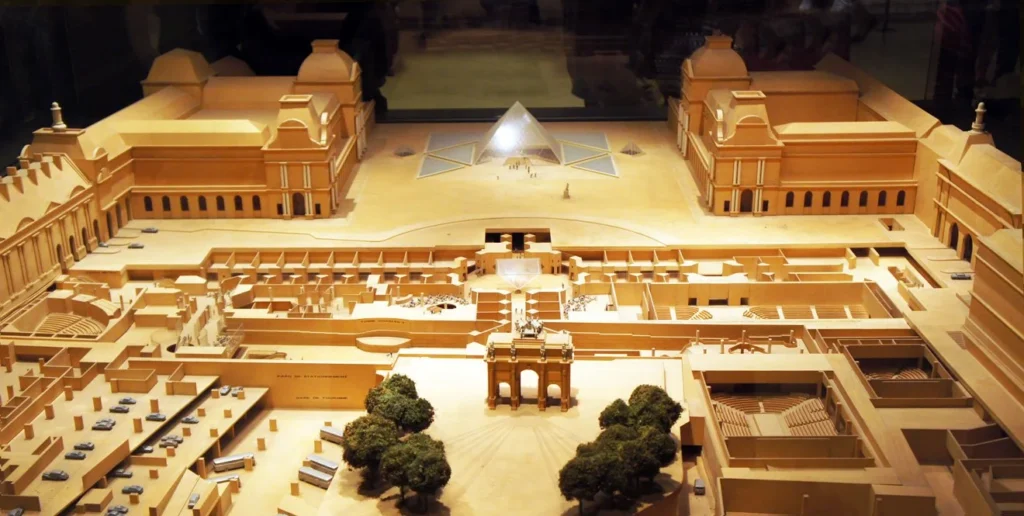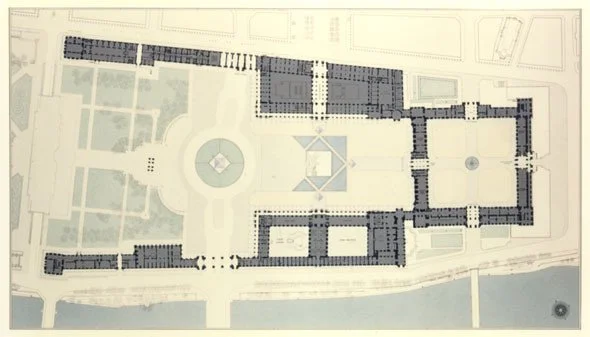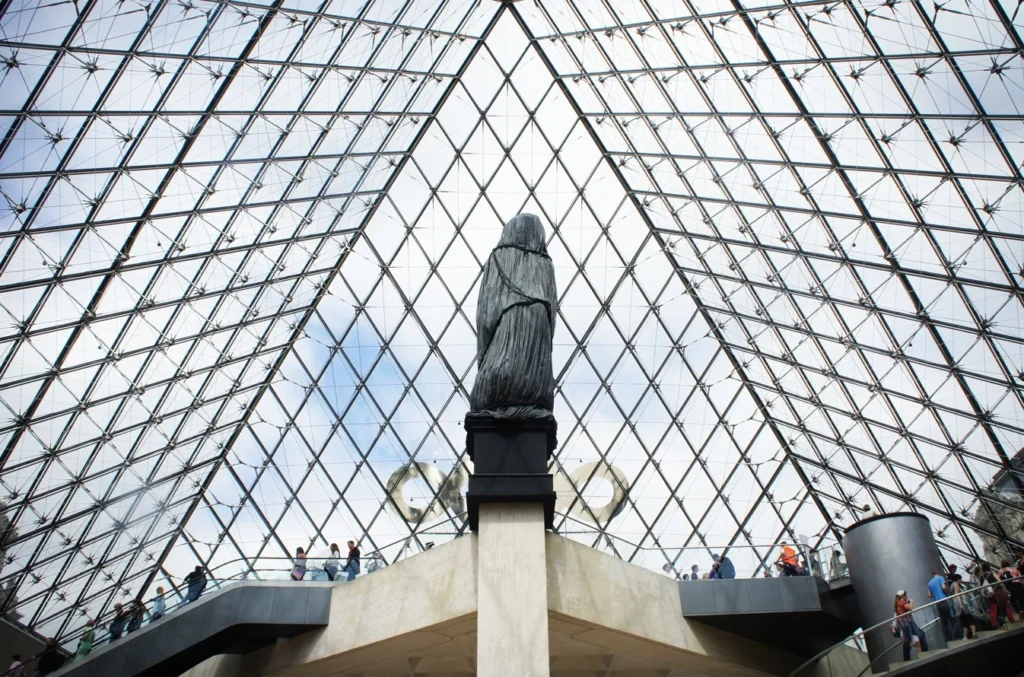I.M. Pei’s Grand Louvre is a masterpiece of modern architecture. I was fortunate to travel to the Louvre in 2012 and spent multiple days at the museum. On the second day, I arrived in the mid-morning and stayed to watch the sunset. Towards the evening, the glass pyramids and the surrounding historical buildings began to illuminate. Reflections of the museum danced on the ponds and created an unforgettable atmosphere. It is an atmosphere I often refer to and try to recreate in my work. The profound impact of this experience prompted me to dig deeper into the story behind how the project was brought to life.
History of the Louvre
The Louvre is a product of five centuries worth of building campaigns. It was once a modest plot of earth sitting along the Seine River on the outskirts of Paris. When the Vikings began invading the city, a fortress with thick walls was erected to help prevent attacks. In 1546 the site was turned into a palace by King Francis I, where he and his court would reside. Nearly every subsequent monarch performed some degree of work on the structure. It remained the royal residence until 1682, when Louis XIV moved to Versailles.
Around the French Revolution in 1789, portions of the Louvre were converted into a museum. During the Napoleonic wars, the French army plundered art and sculpture worldwide. They would bring them back as gifts for royalty, and many would go on display at the Louvre.

The Contemporary Louvre – The Grand Louvre Project
On September 26th, 1981, French President Francois Mitterand announced that the entire Louvre would be made into a museum. (At the time, only a portion of the building was used as a museum).
Mitterrand was passionate about architecture and wanted to leave his mark on Paris. James Gardner notes that “No French leader since Napoleon III, more than a century before, had spent as much time and treasure on building massive projects in the capital.” (Gardner, 336)
Mitterrand wanted the project completed by 1989, which would be the centennial of the erection of the Eiffel Tower and the bicentennial of the French Revolution. This would cement his name into French history.Mitterand appointed Emile Biasini to begin preliminary feasibility studies and assemble the project’s architectural and engineering team.
The Project Brief and Going Underground
The project brief called for nearly 92,000 square meters of floor area. After analyzing this and the rest of the requirements, Pei stated, “It was not possible to imagine creating that much area above ground near the Louvre. Thus we needed to put it beneath the courtyard. The proximity of the River Seine meant that we could not dig too deep without very high costs and technical problems.”
Once it was decided to go underground, Pei would need to devise a solution for patrons to enter the museum and courtyard level and descend underground into the great reception area. The shape and material treatment of the architectural piece that would receive guests at the courtyard level would need to be carefully considered. Pei understood that this piece would become the icon of the Grand Louvre Project.

The Glass Pyramid
In an interview, Pei and his team said they experimented with many different forms for the Louvre. They considered cubes and curved hemispheric shapes. However, when they looked closely at the existing historical Louvre silhouette, there were no curves, so they decided against it. Pei notes, “I concluded that the pyramid was the only acceptable shape. It was the most appropriate form.”
Pei noted that a pyramid shape converges to a single point as your eye moves vertically, eventually dissolving into thin air. The pyramid was one of the least intrusive shapes that could be used. The translucency of the pyramid would allow maximum visibility through and around the structure to the historical buildings at the perimeter. Pei’s highly sensitive and respectful approach honored the architecture of the historical Louvre.

On January 1984, Pei and his team presented the proposal to the authorities. Unfortunately, many critics disagreed with Pei’s approach. Pei mentions, “I had fully expected controversy in this instance, and I was not surprised when we were attacked. But this did not disturb me because I felt we were right.” Much of the credit for organizing forces and traversing through the resistance can be attributed to Emile Biasini.

Throughout the process, critics barraged the project with doubts and skepticism primarily due to the stylistic conflict between Pei’s glass pyramid and the surrounding classical buildings. French architectural classists were irate at the thought of a modern glass pyramid on the site. Through the tenacity of Pei and French Republic President Francois Mitterrand, the project would gain the necessary approvals and be approved to proceed to construction.
The Louvre Today
Over thirty years have passed since the opening of the Grand Louvre renovations done by Pei. Today the Louvre is perhaps the most incredible museum in the world, housing art from almost every age and region. Each year the attendance at the museum exceeds 8 million people. With the demands from growing attendance, we have to ask ourselves, what does the next round of improvements look like for the Louvre?
